|
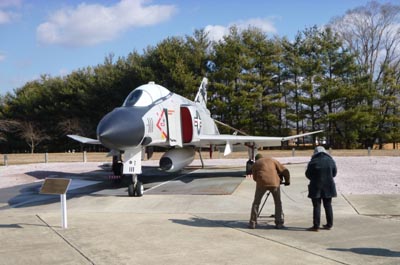
The
cameraman and producer get some "B roll" shots
from around the base. (Copyright Lee
Krsytek, 2013)
|
My
Seven Minutes of Fame with the Travel Channel
In 1968 Andy Warhol, said "In the future, everyone
will be world-famous for 15 minutes." I think I may have gotten
7 minutes of that 15 the other day. Well, maybe not 7 - probably
less. It kind of all depends. I'd better start from the beginning.
Mid-December 2012 - I get an email in my
Museum account from a researcher associated with a new documentary
show that will be airing on the travel channel. (Since the show
has not been announced, I've been asked not to mention the title,
and just to be on the safe side, I'll give everybody involved
with this little tale an alias). Anyway, this researcher (I'll
caller her Lindsay) wonders if I would be able to be a guest
on the show to talk about the crash of the Hindenburg and the
possible reasons the disaster occurred. If I'm interested she
will set up a time when I can talk on the phone with a producer
of the show.
Now for people unfamiliar with the Hindenburg's
story, I'll point you to my article on it (The
Mystery of the Hindenburg Disaster). Now I know quite
a bit about the Hindenburg and airships, in fact right now I'm
working on an article about The Norge, the first dirigible
to fly over the North Pole. Still, there are plenty of Hindenburg
experts out there who know the story better than me, so I'm
not exactly sure why they want me, but I figure, nothing ventured,
nothing gained. I send a message back to Lindsay telling her
that we can set up a time where I can talk on the phone.
A few days later on a Saturday afternoon, I get
a call from Susan, the producer. I've pulled out all my reference
materials on the Hindenburg and they are spread across the coffee
table in case she asks me a fact or figure I can't remember
off the top of my head.
The conversation goes on for almost an hour with
me answering her questions. In the end she thanks me and we
hang up. Given my garbled answers and awkwardly constructed
replies, I figure I'll never hear from her again.
A week later, I'm surprised to get a call from
Susan. She wants to run a few dates by me when I can come out
to Lakehurst Naval Air Station (where the Hindenburg went down)
to shoot at the memorial there. Fortunately, this isn't more
than a couple hours drive from my house and since the college
is on winter break, so my schedule is pretty open. The real
problem will be getting onto the site of the crash itself to
film the monument located there. Lakehurst is a military installation
security is really tight ever since 9-11.
Nothing happens, however, until after the holidays
are over and school is starting up again. I tell Susan on a
later call this means that my only free days are Wednesdays.
Susan calls and asks if February 6th - a Wednesday - works for
me. It does, so she will check with the Navy and get back to
me.
|
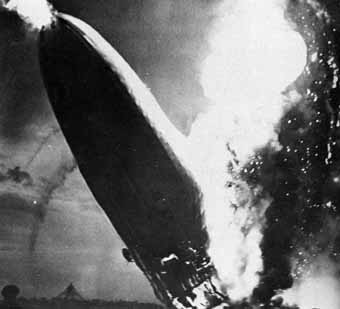
The
object of the segment: The Hindenburg in flames.
|
A few days later I get another call. We are on
for the 6th and she wants to know if I can meet them at the
base's main entrance at 9AM. I agree and Susan tells me her
assistant producer, Elaine, will send me wardrobe guidelines.
The wardrobe guidelines arrive: "No ties or bow
ties, no sweater vests, no white or cream, no patterns. Bring
a VARIETY of options to the set so we can see what works best
for the camera - button downs in neutral (like dark grey or
blue) or jewel tones are best."
This actually eliminates most of my current wardrobe,
which really isn't all that extensive in the first place. Everything
I have either has a pattern or is white or cream. I finally
find four button down shirts that might work: dark green, slightly
lighter, dark green, a medium rust color and finally a dark
gray with a tiny pattern which is almost invisible.
Worrying me more than the shirts are what I can
wear for a jacket for the outside shots. I have a brown leather
one that I love. It's a dead ringer for the one Indiana Jones
wears. The problem is that it's more than ten years old and
in such shabby shape that even that sartorial challenged archeologist
would refuse to wear it. I've wanted to replace it for years,
but can't find another one quite like it. In desperation one
evening I go out and my wife helps me find a black leather,
bomber style jacket. Bomber jacket - airship story, I guess
it should work.
The evening before the shoot I decide that it
makes sense for me to put together a notebook with everything
I know about the Hindenburg story, especially all the relevant
facts and figures that I'm likely to forget. I find a little
leather notebook that I like - it reminds me of the one Indy's
father carries in The Last Crusade - and fill it with
every item I think that might come up. I also glue in diagrams
such as the flight path of the airship over the field on its
approach and various sketches showing the internal structure.
I don't know if I will actually refer to this at all, but having
it in my pocket during the shooting will be reassuring.
February 6th - 9AM: I've been parked in
front of the visitor center at Lakehurst for 15 minutes. My
cellphone rings. It's Susan. They are pulling into the parking
lot and ask what kind of car I'm in. I tell them a black KIA.
I see them pull up in a white van.
We quickly shake hands. The crew consists of Susan,
the producer, Elaine, the assistant producer, Michael, the cameraman
and Stuart, the sound guy (Again, all aliases). Susan is really
nice, but she looks tired. I find out later that she and Elaine
just flew in last night from a 14-day trip to the west coast
where they were filming other segments for the show. Apparently
being a documentary filmmaker for a TV channel can be an exhausting
profession.
We go into the visitor center where we meet our
assigned press rep., Lt. Smith. She's blond and around 25 years
old. She gets our names, then tells us that we will need to
have our vehicles searched before we can drive them onto the
base. I hop into my car and follow her to an open canopy area
behind the visitor center where a stern looking security officer
instructs me to get out of the car, open every door on it (including
the glove compartment and the console storage) and step away.
Another officer brings a German shepherd around to sniff the
car out. After the dog approves of my choice of conveyance,
I am told to drive it out of the way. The film crew's van is
next. This takes a lot more time as they have boxes and boxes
of camera equipment that must be checked.
9:30AM - We finally follow Lt. Smith onto
the base and stop at hanger #1. This is a huge building that
was built in the years just before World War I to house gigantic
dirigibles. It's 806 feet long, just two feet longer than the
Hindenburg. You could put two and half football fields on the
floor of this thing and still have space left over for a couple
of basketball courts. The hanger also has some smaller rooms
on the side including an area the Navy gives over to the Historical
Society.
One of the senior members of the society (I'll
call him "Fred") drives out with us to the actual crash site
on a windswept field perhaps ¾ of a mile from the big hanger.
In the center of the field is what we are actually here to film:
The Hindenburg Disaster Memorial. It reminds me of a patio about
60 feet long and ten feet wide positioned where the Hindenburg's
control cabin came to rest after the crash. It has a vaguely
coffin shape. I don't know if the designers actually intended
that or if it was just a coincidence. In the very center of
it is a marble slab, and on that is mounted a metal plaque commemorating
the 36 lives lost in the disaster.
|
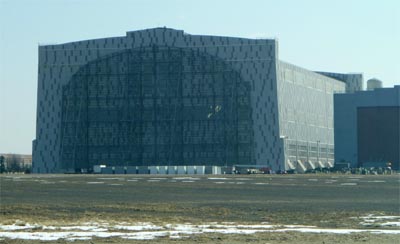
The
immense hanger #1 as seen from the Hindenburg crash site.
(Copyright Lee Krsytek, 2013)
|
While waiting for the crew to set up the camera
and brush a tiny layer of snow off the monument, I pull out
my notes and orient myself so that I know from which direction
the Hindenburg approached from, how it circled the field, and
finally, which direction it was facing when it crashed. Susan
wants me to do a "walk and talk" around the monument explaining
what happened with the airship here. I feel good now that I've
gotten myself properly oriented so that I know how to present
things.
My confidence is suddenly shattered, however,
when Fred announces to everybody that the airship crashed facing
the opposite direction from what my notes say. If I can't get
this right, what else have I gotten wrong?
Stuart, the sound guy, comes over and puts a
wireless microphone on me. The wind is whipping around us and
I have my doubts about whether he will be able to get anything
useable. I hope it works out. I think the "walk and talk" will
look great as long as people can hear me.
To say it is cold out here is an understatement.
It's not so much the temperature. It's actually above freezing
and the sun is popping in and out of the clouds, but the heavy
wind makes it feel like it's sub-zero. Fred remarks that it
is always cold and windy out here.
Some of the other guys from the historical society
come out and join us. I get introduced to Jim. I immediately
warm to him as he's about my age and has a deep enthusiasm for
the history of airships. We talk for a while about the different
theories of what caused the ship to crash. Without realizing
it he also boosts my confidence when he tells me that the airship
crashed facing the opposite way from what Fred just stated.
Apparently my interpretation of the landing pattern was correct
after all. He also points to where the camera crews and reporters
where standing when the crash occurred, a fact that I decide
to incorporate into my "walk and talk."
We start the "walk and talk." The cameraman has
me walk onto the memorial from the field and stop on my "mark"
- a place the Susan has designated on the ground with a pebble.
I then turn and describe the approach the ship made and how
it was hanging above this location at a height of 200 feet when
the fire broke out. We do this over several times. There isn't
any script, so I'm pretty much winging it and sometimes I stumble
and it's a do over. To make things even more difficult, Lt.
Smith interrupts me after the first time and tells me that I
can't refer to the place as "Lakehurst Naval Air Station", which
it was when the Hindenburg crashed in '37. I must use the current
tongue-twister name of "Joint Base McGuire-Dix-Lakehurst." Wedging
this successfully into my talk requires a few more takes.
Complicating things even more is that after the
first run the sound guy tells me not to turn when describing
how the Hindenburg's flight path goes behind me as this exposes
the mic to the wind and he can't hear me. Despite all these
restraints, however, Susan, who has her head tucked into a portable
monitor strapped to her chest, finally approves a version of
the talk. She then tells me to go warm up in my car til I'm
needed again.
Instead I actually go over to Jim and we kibitz
a bit more about airships and what the history of aviation would
have been like if the disaster never had occured. After a while,
however, the cold is just too intense and I climb into my KIA.
I'm just starting to get warmed up when I see
the assistant producer, Elaine, waving to me. They need me for
my "hero" shot. This is the only time I get to actually look
into the camera. I don't need to do much, just stand on the
monument and look thoughtful. The cameraman takes the shot a
dozen different ways, panning on to me from the left, right,
up, down and some other ways I can't even remember. Finally,
I return to the car again and warm up, only to go back out.
They've relocated the camera to the roof of the van to get a
high angle shot and they want me to do the "walk and talk" again
so they can get a distant view of it. The nice thing about this
is that I'm not wearing the mic and I can babble on about anything
I want. They just need my hand motions. They will match this
up with the audio I did earlier.
I do it once, but Mike informs us that we have
to do it again. Elaine sat down on the edge of the van causing
the camera to rock. She apologizes and Mike says not to worry
about it. He's pretty easy-going. I don't mind it either because
it makes me feel like I'm not the only one screwing up and causing
them to do multiple retakes.
11:30 AM - We finally finish up at the
field and head back to Hanger #1. The crew needs shots inside,
outside the hanger, plus a few of some aircraft on display at
a little park across the street. We also explore the small museum
that the historical society runs. The room is only about 20
feet by 20 feet, but it's packed with memorabilia. There are
huge models of dirigibles and blimps hanging from the ceiling.
The Hindenburg and each of the four dirigibles operated by the
U.S. Navy have their own cases full of artifacts. Susan sees
a chunk of the remains of the airship U.S. Akron, which was
lost at sea in 1933, and thinks it would make a great segment
for another show. I agree.
|
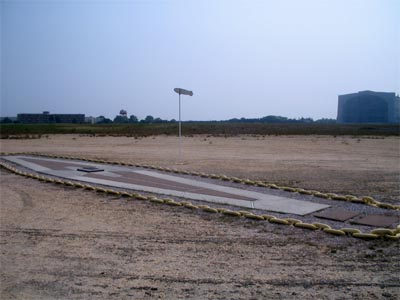
The
Hindenburg memorial is located where the ship's control
car came to rest after the crash in 1937.
(Photo by Ori. Licensed under the Creative
Commons Attribution-Share Alike 3.0 Unported)
|
The interior of the hanger is almost unbelievable.
While we're waiting for the crew to shoot some more "B roll"
- background shots - Jim shows me the control car replica that
was built for the 1975 film The Hindenburg. He tells
me that last year a documentary crew came by, brought in some
actors dressed in uniforms, and used it to recreate the disaster.
12:35 PM - They crew is done with their
shots around the hanger and other parts of the base and we leave.
They still need to do a straight question and answer interview
with me, but the base had no place that's appropriate for that
so we need to go to a hotel and rent one of their meeting rooms.
First, however, they need to get some more "B roll" around the
town of Lakehurst itself. Susan kindly tells me I can drive
over and wait at the pub where we will have lunch, but I decide
to tag along. One of the reasons I decided to do the interview
was that I wanted to see just how a segment like this is put
together. Besides, the battery on my cell phone is getting weak
and I'm afraid of losing contact with them.
1:40PM - We finally get to eat. Everybody
seems happy with the pub Susan has chosen. Elaine, representing
the production company, is buying. I order a cheddar-bacon burger
with sweet potato fries. As we await the order I pepper the
crew with various questions. Susan tells me she likes working
on this new series because she gets to pick who she does her
interview with, because sometimes she has to interview the ranking
person at whatever institution they are visiting and those people
don't always make the best interviews. This makes me feel better
because she must have decided on the phone that I would be a
better interview than some other possibilities. I also ask her
how much of what they shoot with me today will get into the
seven-minute segment as compared to having somebody do a voice-over
with historical shots. She replies, "not to put the pressure
on you," but it depends on how good an interview I give.
My questions reveal that life on the road with
one of these shows is draining. I always thought that it would
be fun to be the host of some mystery or science show on one
of these channels, but even doing this gig for a day I see how
much work it would be. They do a month of straight of shooting
and each day runs 10 or more hours. Then they are back to the
office for a month researching more stories. Yes, sometimes
you get to travel to exotic locations (Our cameraman had just
come back from shooting in Hawaii) but beyond the particular
places you are photographing, you only get to see your hotel
room.
2:45 PM - We finally get to the hotel.
The crew starts setting up for the interview. Susan tells me
this will take almost an hour. In the meantime I'm sent out
to my car to get my shirts. They pick out one of the green ones.
After I change, I sit and watch them put things together. Behind
the chair I will be sitting on they stretch a plastic sheet
that causes the background to look a little fuzzy. They also
set up two stands with boom arms that hang almost over the chair.
One holds a microphone and the other a lamp. Stuart also sets
me up with a wireless mic that tucks into my collar. Behind
the sheet of plastic they get one of the small tables from the
conference room and stack some crystal glasses on it. By lighting
that from the side they hope to give the shot an interesting
background. When Mike looks through the camera, however, he
notes that it looks like a pile of beer cans. They rearrange
the glasses to give them a different appearance.
Elaine sits me down and starts doing my makeup.
She asks me if I mind doing the interview without my glasses.
This will make it easier to light me. I say that's no problem
as long as I don't have to read anything at a distance.
3:35 PM - We start the interview. Susan
asks me how I would like to be referred to on the show. Usually
I use the term "Curator," however I want to make it clear that
I'm not connected with the museum at Lakehurst. I decide that
simply "Historian" would be best.
|
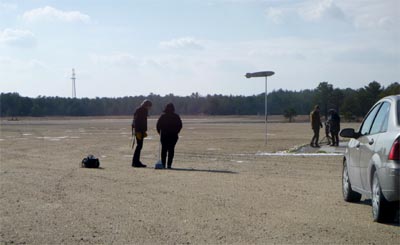
As
I cower in my car the crew continues to brave the cold
wind taking video around the monument.
(Copyright Lee Krsytek, 2013)
|
The interview actually reminds me of one of those
police interrogations you see in the old movies. It's not that
Susan isn't being super nice about asking me questions. She
encourages me to think of this as bring similar to the conversation
we had on the phone. Or maybe like talking to a student. The
problem is that during most conversations I'm not sitting in
a dark room with a light shining in my face as four people stare
at me and I have to worry about sitting with my feet flat on
the floor while keeping my upper body in the frame of the picture.
This makes things slightly more difficult. Susan assures me,
however, that I will "warm up" after a while.
The interview also reminds me of an interrogation
because I'm answering the same questions over and over again.
Half the time the reason is that partway through my answer I
stumble and we have to do it over. The other half is because
the room we rented is not ideal. The street outside is noisy
and in the hallway the elevator is dinging every few minutes.
This means even when I give a perfect answer, often I have to
do it again just for safety.
Elaine is sent out into the hall to quiet people
down. She puts up a sign on the door that says, "Quiet Please,
Filming!" However this just causes people to talk more as they
want to know what's being filmed.
I'm impressed that Susan has gotten so well versed
in the subject of the Hindenburg. She has all my remarks from
the phone conversation written down plus other information she's
found out. Again it's a bit like a police interrogation. "Mr.
Krystek, on your testimony last week you said that the Hindenburg
was as long as four 747s! But now you say that it was only as
long as three!" I admit that sometimes I'm guilty of screw ups
like that, but mostly because I did some additional fact checking
in between.
The experience garners in me a lot of sympathy
for anybody being interviewed. It's really hard to come up with
good clear answers on the fly even when you know your subject
well. I can see how when the elements are edited together in
the end you might seem to be saying something that you really
didn't mean. Not that Susan is trying to do that at all. I'm
just afraid that the editors, who don't know the story as well
as she does, will cut this together and it might not come out
like it should.
The total segment is only seven minutes, but my
interview runs for over two hours. At the end Susan asks me
if there is anything I want to add. By that time my brain is
basically spaghetti and I can't think of anything. Of course
30 minutes later in the car on the way home I come up with what
would have been a killer concluding statement. Oh, well…
5:45PM - The crew packs up and I say goodbye.
Elaine gives me some gas money and I suggest a future story
idea to Susan, telling her I will email the relevant information
to her. I can see why she looks exhausted. She left her apartment
at 5AM to pickup her crew and she won't be getting home to NYC
until at least 8 o'clock.
The whole experience has given me real insight
into how these types of shows are put together. I often watch
Mythbusters, Samantha Brown or any of those documentary-type
shows and think what a great job that would be. The truth is
that it's a lot of work with long hours and little time at home.
After seeing this would I really want to host
a show on the Travel Channel if I had the chance?
Well, the truth is probably yes.
Update: Since this article came out the show has premiered
and the episode broadcast. The show was Monumental Mysteries
and the episode was #5. Unfortunately the walk and talk didn't
make into the final cut. A link to part of the segment on the
Travel Channel website is here.

Copyright
2013 Lee Krystek. All Rights Reserved.